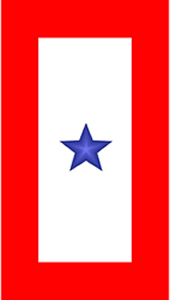In January of 1942, following the outbreak of World War II, a newspaper in Flint, Michigan advertised a meeting for mothers of servicemen, led by Captain George H. Maines. Hundreds of mothers attended this meeting.
The Blue Star Mothers’ original goals were ”to bring our sons home, to ensure they received the benefits they deserved, help service member’s families, help each other and to be there if something happened.”
Today, Blue Star Mothers support each other, send Freedom Boxes and letters of encouragement to our troops; help our wounded service people, volunteer in VA hospitals, and work with veterans. We show our children and America's sons and daughters that we appreciate them and their service to our Country.

The Service flag is an official banner authorized by the Department of Defense for display by families who have members serving in the Armed Forces during any period of war or hostilities the United States may be engaged in for the duration of such hostilities.
The Service flag, also called the Blue Star Flag, was designed and patented by WWI Army Captain Robert L. Queissner of the 5th Ohio Infantry who had two sons serving on the front line. The flag quickly became the unofficial symbol of a child in service. President Wilson became part of this history when in 1918 he approved a suggestion made by the Women's Committee of the Council of National Defenses that mothers who had lost a child serving in the war wear a gold gilt star on the traditional black mourning arm band. This led to the tradition of covering the blue star with a gold star on the Service flag to indicate that the service member has died.
During WWII the practice of displaying the Service flag became much more widespread. Most flags were hand made by mothers across the nation. One of the most famous flags was that of the five Sullivan brothers who all perished on the U.S.S. Juneau.
The Department of Defense specifies that family members authorized to display the flag include the wife, husband, mother, father, stepmother or father, parent through adoption, foster parents who stand or stood loco parentis, children, stepchildren, children through adoption, brothers, sisters and half brothers or sisters of a member of the Armed Forces of the United States. The flag should be displayed in a window of the residence of persons authorized.
The Service flag may also be displayed by an organization to honor the members of that organization serving during a period of war or hostilities.
If the U.S. flag is also displayed with the Service flag, the U.S. flag should be of equal or greater proportions and should take the place of honor above the Service flag.
Each blue star on the flag represents a service member in active duty. A gold star is displayed if a service member is killed in action or dies in service. If several stars are displayed by one family the gold star takes the honor of being placed at the top. The gold star should be slightly smaller than the blue star to create a blue border surrounding the gold star.
